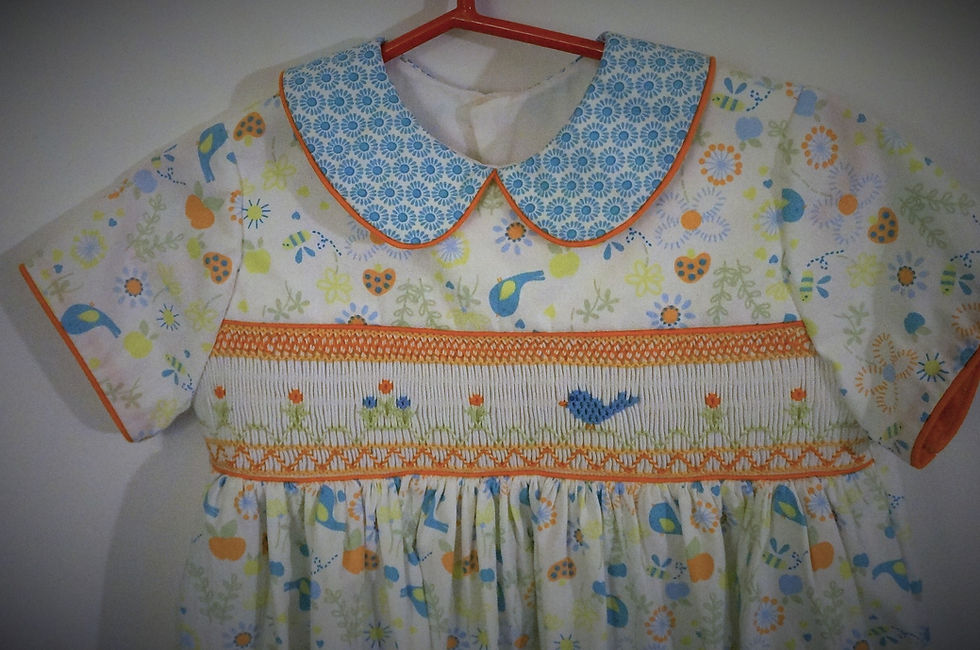Smocking: Choosing a Fabric
- Lisa Hawkes
- Aug 9, 2023
- 4 min read

I am back with the next in our Smocking: The Basics series. Today we are going to discuss fabric selection. Many different fabrics may be smocked, but some are definitely easier than others, so the purpose of today’s post is to give you a sense of where to start. What is the easiest fabric to work with, both from a pleating and smocking perspective? I mention both a pleating and smocking perspective because the two are not the same thing. In general, a loosely woven fabric will be the easiest to pleat, but the resulting pleats may be floppy, difficult to smock, and not give the most pleasing result. The sweet spot is a fabric that pleats easily, and results in full pleats that hold their shape well.
I recommend starting with a 100 percent cotton broadcloth, Imperial Broadcloth by Spechler Vogel (65 % cotton, 35% polyester) or poly cotton broadcloth from Fabric Finders. Please note that I listed the particular manufacturers for the poly cotton broadcloth. I don’t recommend using a mystery broadcloth! Knowing what you are getting when it comes to fabric shopping is difficult, and purchasing a name brand fabric manufactured by a company that has been in business for years and stands behind the product is one way to ensure that you will receive the quality that you need. You could also use Kona Cotton or a high quality quilting cotton.
Broadcloth will have a better drape than a quilting cotton in the finished garment, so it is still my preferred choice for children's clothes. Even with 100% cotton broadcloth there is some difference. I was at a trade show several years ago purchasing fabric for the shop and was surprised when two different broadcloths from the same manufacturer felt very different. The sales rep did some digging and it turned out that the two broadcloths had different thread counts, which gave them a different feel and different densities! (I am always happy to let you know how one of our fabrics pleats up - just email me!) I don't recommend a lawn or batiste for your first project although both will pleat up beautifully. They are thinner, sometimes need more than a 3 to 1 ratio for the pleats to look good, and the pleats can be a little floppy when stitching requiring more expertise from the smocker.
If you wish to choose a print for your first project (and I love prints!), an overall small print will often work better than one with particular motifs and a lot of negative space in the background.
Every smocker has a story of picking a print that they love, pleating it up and being surprised by what they found. A print with a lot of negative space once pleated can result in some very unattractive blobs! All is not lost if this is the case, but the solution is to smock a very dense pattern that covers the blobs. Alternatively, smock an inset on a solid color fabric and use the print for the main part of the outfit as I did with the Little Birdy Dress below.
For a first project, if choosing a print, choose one that densely covers the fabric and you should be fine. Another plus for a small print is that more often than not, prints are not printed on grain. You want to pleat on grain, and with a small overall floral, there will not be any specific motif that your eye will be drawn to that is “traveling” down the outfit because you pleated on grain and the pattern isn’t on grain.
When you actually go to pleat up your first project, the general rule is that the fabric to pleats is a 3 to 1 ratio, in other words, 30 inches of fabric pleats up to 10 inches of smocking. But as Hector Barbossa says “The code is more what you'd call 'guidelines' than actual rules.” A thin fabric such as a batiste or lawn may need more fabric to achieve the same finished width. A corduroy, or knit may need less fabric to achieve that width. The pattern will give you a specific width to pleat, and if you take the above fabric recommendations, you should find that the pleated fabric has a good pleat density. As you try other fabrics, or if you just want a little extra security, pleat the entire width of fabric rather than cutting it first. For example, if you are pleating an insert and are making a size 4 square yoke dress, the pattern may direct you to pleat a 45 inch wide piece of material. If you are using Imperial Broadcloth, it is 60 inches wide. Pleat the entire 60 inches. Pull it up to the width that the pattern recommends and see how it looks.. If it is too full (and yes, this does happen), then pull out some of the pleats and cut the piece down. It is much easier to take fullness out than to compensate for the lack of it!
I hope these fabric recommendations help you get started on your first smocking project. For the other posts in The Smocking Basics series, see:
For help with the individual stitches, see the Smocking Stitches Guide!









